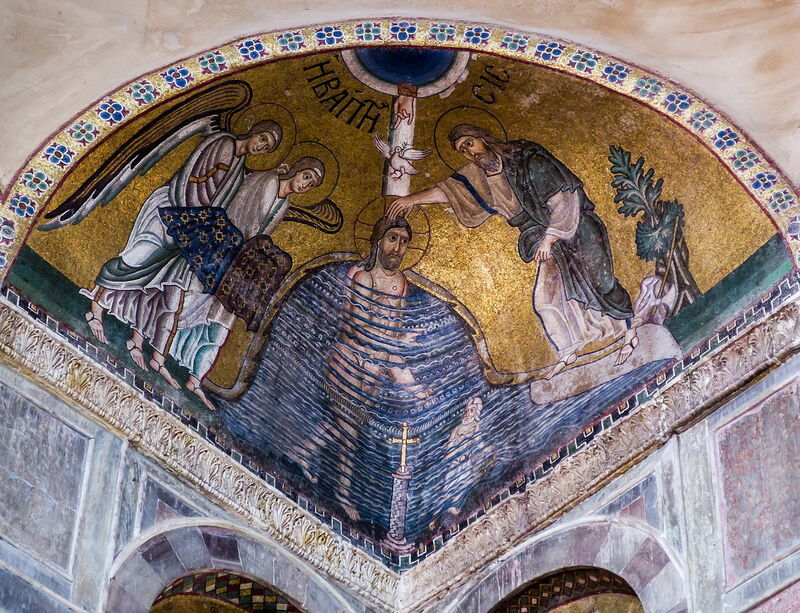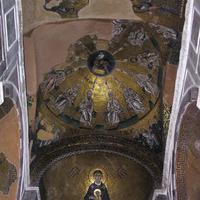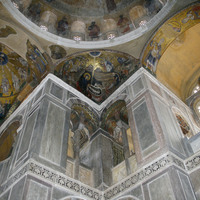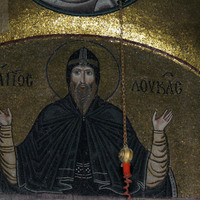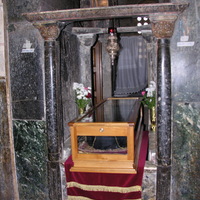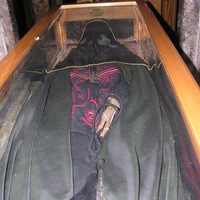Monastery of Hosios Loukas
Type:
Monasteries,
Churches,
Mosaics,
Wall paintings
Date:
Second half of tenth to first half of eleventh century
Location or Findspot (Modern-Day Country):
Greece
Description:
The monastery dedicated to Hosios Loukas (Blessed or Holy Luke) near Steiri, in central Greece, is named after Luke (896–953), a travelling monk and healer who spent his last years there and was buried beneath his cell. Luke's tomb had a reputation for miracles, which in turn attracted pilgrims to the site. In the first half of the eleventh century, a groin-vaulted crypt was constructed around the tomb, but Luke's remains were later moved to a marble shrine upstairs. This shrine was at the juncture between the narthex of the Panagia Church (older, north church) and the monastery's new katholikon (main church).
Above the colored marble on the walls are mosaics in the upper zones of the katholikon. The dome mosaic was lost in an earthquake, but its painted replacement probably reflects its original Pantokrator. There are Christological scenes in the squinches of the central dome (one squinch has lost its decoration), scenes of Christ's Passion and Resurrection in the narthex, and images of saints throughout.
Devoid of its principal relics, the crypt—which resembles a cross-in-square church in plan—became a mortuary chapel for the monks. Its walls are frescoed at eye level with scenes of the Passion of Christ and the Koimesis; in the vaults are medallions of saints, apostles, and holy men, including Luke. The paintings were probably completed in the mid-eleventh century. Subterranean crypts are rare in Byzantium. This one provided the substructure needed to support the katholikon at the same floor level as the Panagia Church, but it may also have imitated crypts that housed tombs of notable early Byzantine monks in Palestine or, perhaps, the crypts that were increasingly common in Western European churches.
Relevant Primary Sources
Above the colored marble on the walls are mosaics in the upper zones of the katholikon. The dome mosaic was lost in an earthquake, but its painted replacement probably reflects its original Pantokrator. There are Christological scenes in the squinches of the central dome (one squinch has lost its decoration), scenes of Christ's Passion and Resurrection in the narthex, and images of saints throughout.
Devoid of its principal relics, the crypt—which resembles a cross-in-square church in plan—became a mortuary chapel for the monks. Its walls are frescoed at eye level with scenes of the Passion of Christ and the Koimesis; in the vaults are medallions of saints, apostles, and holy men, including Luke. The paintings were probably completed in the mid-eleventh century. Subterranean crypts are rare in Byzantium. This one provided the substructure needed to support the katholikon at the same floor level as the Panagia Church, but it may also have imitated crypts that housed tombs of notable early Byzantine monks in Palestine or, perhaps, the crypts that were increasingly common in Western European churches.
Relevant Primary Sources
Relevant Textbook Chapter(s):
6
Repository and Online Resources:
• Hosios Loukas is part of UNESCO's World Heritage List.
• Explore 3D panoramas of Hosios Loukas via Columbia University's Media Center for Art History.
Image Credits:
Brad Hostetler, Linda Safran, Wikimedia Commons, Navid Jamali
